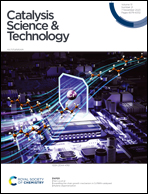Preparation of Ru-doped Cu-based catalysts for enhanced electrochemical ammonia synthesis from efficient electrocatalytic nitrate reduction
Abstract
Ammonia (NH3) is not only an essential feedstock for fertilizer, but also deemed as a potential hydrogen carrier. Worldwide industrial-scale NH3 synthesis relies heavily on the Haber–Bosch process, which involves harsh operation under reaction conditions. In addition, nitrate is prevalent in groundwater and surface water, causing serious pollution. Electrocatalytic nitrate reduction reaction (NITRR), a sustainable ammonia synthesis technique, is the most promising alternative to the traditional Haber–Bosch process. We combined the noble metal Ru by impregnation based on Cu-based materials that can inhibit the HER to prepare Cu/Cu2O/RuO2@C composites. Surprisingly, the NH3 yield of Cu/Cu2O/RuO2@C composites prepared by the NITRR reached 209.44 μmol cm−2 h−1 and 82.40% Faraday efficiency at −0.6 V (vs. RHE). Such a high reduction activity is attributed to the synergistic effect between Ru heteroatoms and the Cu-based material. In addition, Cu/Cu2O/RuO2@C exhibited good cycling stability and repeatability. This work highlights the potential importance of electrocatalyst design, contributing to research and exploration of related materials.



 Please wait while we load your content...
Please wait while we load your content...